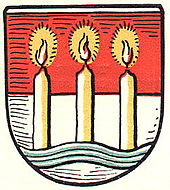Groß-Lichterfelde
Groß-Lichterfelde was an independent municipality southwest of Berlin from 1877 to 1920 and belonged to the Prussian administrative district of Potsdam , district of Teltow . Today it forms the Berlin district of Lichterfelde in the Steglitz-Zehlendorf district . Towards the end of the 19th century, Groß-Lichterfelde was one of the wealthiest communities in the German Empire and was considered one of the most elegant new residential areas outside the center of Berlin.
history
Groß-Lichterfelde consisted of the historic villages of Lichterfelde and Giesensdorf , both mentioned for the first time in the 13th century, and the two Wilhelminian-style villa colonies of Lichterfelde West and Lichterfelde East that were established in 1860 . The privately financed villa colonies were transferred by their founder Johann Anton Wilhelm von Carstenn to the Kingdom of Prussia by means of a donation agreement, which in return undertook to take on certain tasks for all time. With the rapid population growth of the two villa colonies (1875: 946 inhabitants, 1880: 4049, 1885: 5900), a more efficient administrative structure became necessary, whereupon the decision was made to found a unified municipality . Groß-Lichterfelde received its own registry office with the introduction of the Prussian registry offices in 1874 . With the construction of the Anhalter Bahn , the Lichterfelde station (today: Berlin-Lichterfelde Ost station ) opened in 1868 , followed shortly afterwards in 1872 by the Lichterfelde station (Potsdamer Bahn) - today: Berlin-Lichterfelde West station - on the main line to Potsdam, which opened in 1846 and Magdeburg . The S-Bahn Berlin currently runs to the stations (as of 2016) with its lines S1 (Lichterfelde West) and S25 (Lichterfelde Ost).
Groß-Lichterfelde housed u. a. the Prussian Main Cadet Institute , the Guard Rifle Barracks of the Prussian Guard Rifle Battalion and the Royal Prussian Materials Testing Office (today: Federal Institute for Materials Research and Testing ) and the Anatomical Computing Institute (dissolved in 1945). From 1897/1902 the Royal Botanical Garden was found here (today: Botanical Garden Berlin ). Meyers Konversationslexikon from 1885 also lists "a pedagogy , a higher boys' school , a Johanniter hospital, many beautiful villas ".
The interior of the cadet school resulted in an increased influx also young nobility families, resulting in adjacent to the newly rich bourgeoisie in the early Belle Époque of the late 19th century, typical of the Lichterfelder residential areas conservatively - German national emerged social class. In this mixture, the "new building project" of the Lichterfeld villa colonies differed significantly , both from the more developed inner-city residential areas in Berlin and from other villa colonies that remained largely bourgeois. Several generations of later top officers in the German Army , Reichswehr and Wehrmacht received their training at the Lichterfelde Cadet Institute. Their influence was so formative that by the end of the Second World War the term "Lichterfeld" was used as a synonym for the elitist officers of the Prussian cadet institute. With the arrival of their families, Groß-Lichterfelde was increasingly seen as the place of birth for the next generation of the elite and as the final resting place for important military personnel as the “best address”.
With 47,213 inhabitants at that time, Groß-Lichterfelde went together with the neighboring communities of Steglitz and Lankwitz as XII. Administrative district in Greater Berlin . The place name Groß-Lichterfelde was given up in favor of the residential area names Lichterfelde, Lichterfelde-West and Lichterfelde-Ost , supplemented after the Second World War by city extensions in the southern border area under the name Lichterfelde-Süd .
See also
Individual evidence
- ↑ Ulrich Muhs: Lichterfelde then and now. Architekturverlag Der Zirkel, Berlin 1919
Coordinates: 52 ° 26 ′ 31 ″ N , 13 ° 17 ′ 14 ″ E

